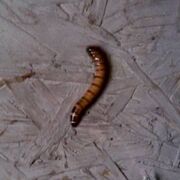
A parasitic ice worm in 1993.
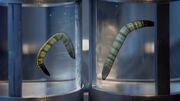
Two of the parasites in jars filled with ammonia.
Parasitic ice worms are a type of worm and parasite found in Icy Cape, Alaska in November, 1993. (TXF: "Ice")
Profile[]
Anatomy and Biological Processes[]
Each of these worms is similar to a tapeworm, as it has a scolex with suckers and hooks, but its anatomy is also highly unusual.
Inside a host, the worm will, if possible, make its way deep inside its host's brain and attach itself to their hypothalamus gland, from where the worm feeds on acetylcholine released from the gland, stopping the host's ability to control their own violent behavior. Surface symptoms on the host's body begin to show within a few minutes of infection and, within a few hours, the worm will have seemingly obtained total control of its host. The worm will only kill its host if it is removed from the host organism, by releasing a poison into the host's body.
An individual worm will not tolerate another invading its host. It does to the invader what it did to humans – it makes them kill; unlike other species, it does not need another of its own species to procreate as worms are hermaphroditic and can reproduce, itself. Introduction of a worm into an already infected host will kill both worms and cause the host to squirm uncontrollably for a few moments, until both parasites are dead.
History[]
The origins of the parasitic ice worms are not entirely known. In 1993, FBI Special Agent Fox Mulder implied that he believed the worms had been brought to Earth on a meteor from space, a quarter of a million years before 1993, and that the parasites had come from a planet with freezing temperatures as well as an ammonia-supported life system. Mulder also subscribed to the unlikely belief that, since their arrival, the parasitic worms had survived in the subzero temperatures of the ice, underground, where they lived in ammonia. Mulder's unconventional theories were influenced by beliefs held by theorists in alternative life designs and by evidence that a meteor crater existed beneath the Icy Cape area. Ammonia was also found in ice from that area and in infected blood, prior to Mulder postulating his theories.

Scientists assigned to the Arctic Ice Core Project, whose violent deaths were attributed to the parasitic worms.
In 1992, a team of five scientists assigned to the Arctic Ice Core Project were sent to Alaska by the US government’s Advanced Research Project Agency. The team was led by John Richter and searched for evidence of the structure of Earth's ancient climate, by drilling down into the arctic ice and retrieving core samples. The team's work was initially believed to be successful but, in early November 1993, the team were victims of the parasitic ice worms and each scientist died after having been infected by one of the worms; three of the scientists were strangled to death by one or more other members of the science team and the last two survivors of the team, Richter and Campbell, killed themselves. After their deaths, all but one of the worms were found to have also died inside each scientist's body, which showed tissue damage due to fever. It was ultimately believed that the parasitic ice worms had been unearthed as a result of the work conducted by the science team, that the worms had caused the scientists to kill each other and that Richter and Campbell's act of killing themselves had been an attempt to save other potential hosts from the parasites.
The parasitic worms, one of which having by now infected a dog that had been accompanying the science team, were provided with the opportunity of infecting other hosts when the AICP investigative team, gathered especially to investigate the deaths of the science team, subsequently traveled from their meeting point of Doolittle Airfield in Nome, Alaska to the deceased team's base in Icy Cape. This group consisted of Agent Mulder and his FBI partner, Special Agent Dana Scully, Denny Murphy (Professor of Geology at UC San Diego), Doctors Hodge and DaSilva (a medical doctor and toxicologist respectively) as well as the team's pilot, Bear.
While attempting to stop the infected dog when it tried to attack Mulder, Bear was bitten by the animal and became a host for one of the parasitic worms. He died soon after the other members of the team removed the worm from the top of his spine. Trapped at the science base due to extreme weather conditions and amid fears regarding the possibilities of who could be infected by the worms, the investigative team discovered that Professor Murphy had secretly been murdered. They also found that killing the worm inside an infected host's body could be done by introducing another of the parasites; using the worm extracted from Bear and the only living worm from one of the deceased scientists, the group successfully used this method on both the infected dog and, after they learned that she was also a host for one of the worms, on Dr. DaSilva.
The survivors were evacuated back to Doolittle Airfield and, forty-five minutes later, the base was incinerated by a group that may have been the US military or the Centers for Disease Control. Mulder, Scully and Dr. Hodge were tested for the parasite but their results were normal and they were consequently released. Dr. DaSilva was placed into quarantine, along with the dog, until it could be ensured that they would not infect the population. Mulder, who had wanted research on the parasites to be conducted, believed that the worms were still living deep under the ice but took Scully's advice to leave the parasites where they were.
Evidence[]
Larvae[]
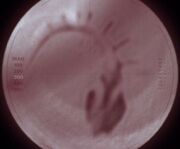
A microscopic view of a parasitic ice worm larva.
The larvae of the parasitic worms were microscopic, single-celled organisms that lived in infected blood, found in the same bodies as the larger parasitic worms. The investigative team discovered one of these in an ice core sample Mulder and Professor Murphy found, while the ice had been melting in the base, and another was found in Richter's infected blood. Scully was the first to identify these organisms as larvae of the parasitic worms and it was by noticing two of these organisms lethally battling each other, after Dr. DaSilva accidentally mixed up blood samples, that Scully realized the method of ridding an infected body of the parasites.
Black Nodules[]
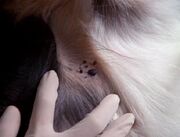
A group of black nodules, a symptom of infection by a parasitic ice worm, found under a dog's limb.
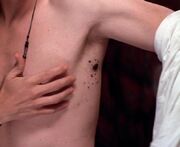
Black nodules on Bear.
The presence of one of the parasites inside a host body caused the host's lymph nodes, under at least one limb, to seem swollen and appear as black nodules. These were symptomatic of bubonic plague.
The investigative team discovered some of these black nodules on the science team's dog, under one of the animal's legs. Soon after, Bear found more of these spots under his right arm. When Scully later examined the science team, she found that none of the scientists had the black nodules. Bear hoped Scully's finding showed that the black nodules were unrelated to the scientists having killed each other, but Dr. Hodge suggested that there may still be a connection as he had just re-examined the dog and found that the nodules had disappeared. This discovery led Dr. Hodge to the incorrect possibility that the spots might be a symptom of a disease at an early stage.
As the team's fears about possible hosts later began to escalate, the members of the team checked each other for the spots but none of the team had them. Scully consequently assumed that the entire team was uninfected but Mulder reminded her that the black nodules on the dog had disappeared. Subsequently, the team's method of checking for signs of infection became examining the top of a potential host's back, which was where Dr. Hodge saw the parasite that was infecting Dr. DaSilva move under her skin, the first indication to any other member of the group that she was a host.
- The black nodules could be related to black drops squirted onto Bear's back by the parasite that is pulled out of him. These black drops, as well as Bear's subsequent death, seem to be the basis for Dr. Hodge's later suggestion that the worms release a poison upon being extracted from their hosts.
Dog[]
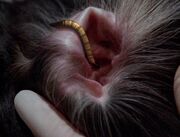
A parasitic worm slithers into the dog's ear.
The parasitic worms not only infected humans, as established by the infection of the science team's dog. Shortly after the dog attacked Mulder, Dr. DaSilva questioned whether the animal, now tranquilized, had rabies but Dr. Hodge replied that the absence of any indication of glottal spasm or tetany meant that, if the dog did have rabies, it was a strain he was unfamiliar with.
As well as the dog's black nodules, the animal also had a skin irritation round its neck that looked as if the dog had been scratching off its own hair. This area was where the investigative team first saw one of the worms, as the hidden parasite crawled beneath the dog's skin. After the extermination of this parasite and the death of the invading worm placed inside the dog via the animal's ear, the dog passed both worms in its stool. (TXF: "Ice")
Hosts[]
- All five scientists assigned to the Arctic Ice Core Project
- John Richter
- Campbell
- Dog accompanying AICP (survived)
- Bear
- DaSilva (survived)
Background Information[]
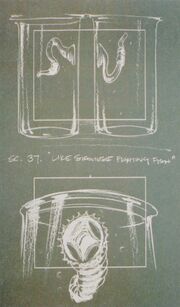
Concept artwork for the parasitic worms.
The task of creating the ice worms and the illusions associated with them puzzled the production crew of The X-Files. As such, Co-Executive Producer R.W. Goodwin once described the effect of "worms wriggling under the skin of people" as "really amazingly challenging to create." (X-Files Confidential, p. 30)
In a featurette on The X-Files Season 1 DVD specifically about the episode "Ice", animal trainer Debbie Coe reveals, "My first meeting at X-Files was over this alien worm. I think it was the special effects person who thought of putting a baby snake in a latex suit." She laughs before adding, "You can't put a baby snake in a latex suit. So, I suggested the worm that they did use, a super mealworm. It's actually like a beetle larva."
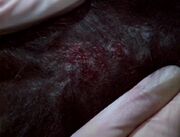
A shot of a hidden parasitic ice worm (right of image) beginning to crawl beneath a section of dog fur with a skin irritation.
The featurette continues with interview footage of makeup artist Toby Lindala, who recalls, "The dog-piece, that was the back of the dog's neck. And essentially, I just took a juice jug, glued the mechanical piece on first. There was a wire, making a loop, and a bunch of beads that were tooled down into these different sort of shapes that would actuate the bump on top, painted very dark so they'd read through, then a gelatin skin, and then a bunch of fur work on top of that. Transferred a lot of bear fur, actually, to match the dog."
In another featurette on the same DVD, Mat Beck, the series' regular Visual Effects Producer, says, "The worm was partly just kind of a real prop that was actually moving around. And it was also a computer-generated worm that kinda wriggled, convincingly."
In an early interview with series creator Chris Carter on the same DVD, he remembers, "We created fake skins, we put them over bottles and we would pull things underneath them. This was also the work of Toby Lindala, our great makeup artist who works on the show. And the dog's fur was also manufactured and wrapped tight over a surface, and then the worm was pulled beneath that. But you also see digital worms – that worm that crawls in the dog's ear is a worm that's been digitally created. So, you get a little of the real, a little of the not-so-real and a lot of movie magic. And we were sure that we had gone too far with this worm, that we had pushed the limits of good taste and creep-out factor, but we all realized how good it would be if we were allowed to keep it in."
Earlier in the same featurette, Carter admits that he thinks seeing the dramatic tension between Mulder and Scully in "Ice" be resolved "as it was resolved, in a rather strange and weird way, with these Arctic worms – one is nearly put into Mulder's body – was, you know, it was just good, good stuff and actually, I think pulled off rather believably."
Immediately prior to Mat Beck's appearance in the featurette that includes the interview footage of him talking about the parasitic worms, director David Nutter exemplifies the way in which the rest of the production staff would strive to make something great by stating, "The meal worm that almost went into Mulder's ear was a real deal."
Some fans of The X-Files have speculated that the parasitic ice worms may have influenced the original concept of the black oil virus, seen frequently throughout the series beginning in Season 3. Although none of the series' production staff have admitted or denied this possibility, the two concepts do share several similarities. In the episodes they are featured in, suggestions are made that both lifeforms came to Earth from space via a meteor. They are also both seen to infect their hosts and manipulate their hosts' behaviors, creating a mood of paranoia. Additionally, both the black oil virus and the substance squirted onto Bear's back by the parasitic worm extracted from him are black, oily substances. As it is later revealed that the Black Oil has taken over all life in the universe except humans and the Faceless Alien Rebels, the Ice Worm may indeed be infected by Purity.